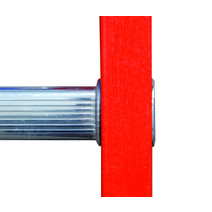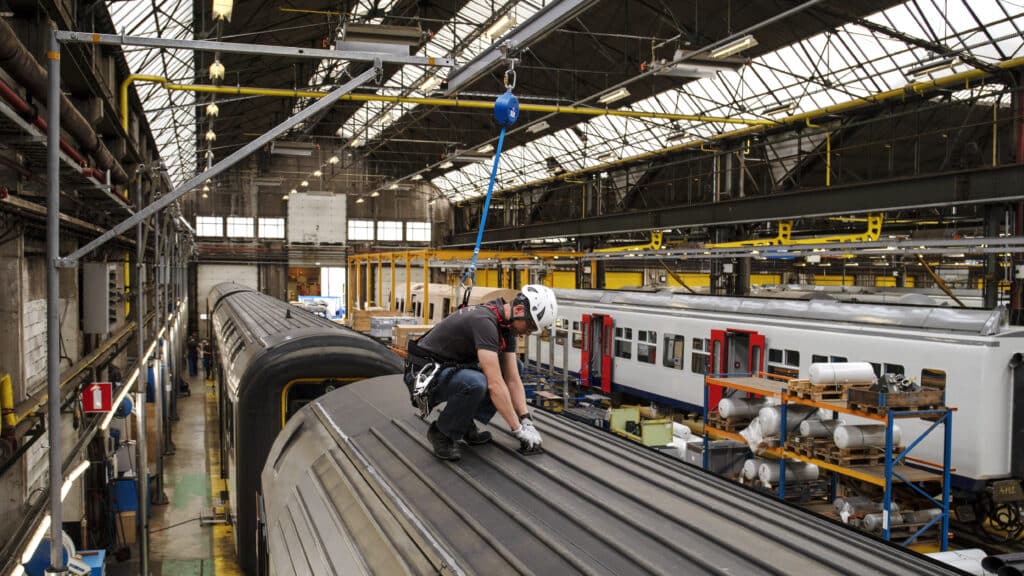STANDARDS AND REGULATIONS FOR FALL PROTECTION EQUIPMENT
PERSONAL SAFETY
The “3-metre” requirement of section 346 of the RSST (Regulation Respecting Occupational Health and Safety):
FALL PROTECTION DEVICES:
The wearing of a full body harness is required where a worker is exposed to a fall of more than 3 m (9.8 ft) from his working position, except where the worker is only using a means of access or exit or where he is protected by a safety net.
This “3-metre” rule is not the only RSST fall-protection requirement. Article 324 deals with fall hazards:
Work involving the risk of falling:
Maintenance, repair, or unjamming work that presents a fall hazard must be performed with the assistance of scaffolds,work platforms, walkways, portable ladders, safety harnesses or other appropriate equipment.

COLLECTIVE SAFETY
GUARDRAILS – ANCHORS – NETS
Guardrails must be designed to withstand a static load of 1 to 1.5 kN vertically and 0.45 kN horizontally, simultaneously.
2.9.3.
Safety net:
When a safety net is installed, it must:
- be placed in such a way as to prevent a person from falling more than 6 m in free fall;
- have a sufficient surface area to intercept a person in the event of a fall;
- be capable of supporting a mass of 115 kg falling from a maximum height of 6 m and with a safety factor of 3;
- be sufficiently flexible to break the fall and retain the person;
- be resistant to atmospheric agents;
- be free of all debris;
- be made of mesh measuring approximately 150 mm x 150 mm;
- be installed in such a way that, upon use, a person falling into it cannot strike an obstacle above or below the net or be struck by any object.
Anchors complying with EN 795 are accepted on construction sites in Quebec. Here is a copy of the regulatory article:
The anchor must be certified for a minimum breaking strength of 18 kN (RSST, art. 348).
Code de sécurité pour les travaux de construction (CSTC) RRQ, c. S-2.1, r.4
Art. 2.10.15. Anchoring system:
The fall-arrest connecting device of a safety harness must be secured to:
- a single anchor point with one of the following characteristics:
a) a breaking strength of at least 18 kN;
b) designed and installed in accordance with an engineer’s plan in compliance with CSA Standard Z259 Design of Active Fall-Protection Systems, and having one of the following characteristics:
i. a strength equal to twice the maximum fall-arrest force as certified by an engineer;
ii. certified in accordance with EN 795 Personal Fall Protection Equipment Against Falls – Anchoring devices published by the European Committee for Standardization or with CAN/CSA Standard Z259 Anchorage Connectors.
2. a flexible continuous anchorage system (horizontal lifeline) with one of the following characteristics:
a) in compliance with the following minimum standards:
i. a steel cable with a minimum diameter of 12 mm released at a minimum angle of 1 vertical to 12 horizontal, or 5° to the horizontal;
ii. a maximum distance of 12 m between end anchors;
iii. end anchors with a breaking strength of at least 90 kN;
iv. not to be used by more than two workers at a time.
b) designed and installed in accordance with an engineer’s plan in compliance with CSA Standard Z259.13 Flexible Horizontal Lifeline Systems and CSA Standard Z259.16 Design of Active Fall-Protection Systems;
3. a rigid continuous anchoring system designed and installed according to an engineer’s plan in accordance with CSA Standard Z259.16 Design of Active Fall Protection Systems.
However, the Règlement sur la santé et la sécurité au travail (RSST)(Regulation respecting occupational health and safety), applicable outside construction sites, does not contain a similar reference, and there is no indication that this will change in the near future. Regulations generally refer to Canadian standards. However, equivalences can be accepted where appropriate.

